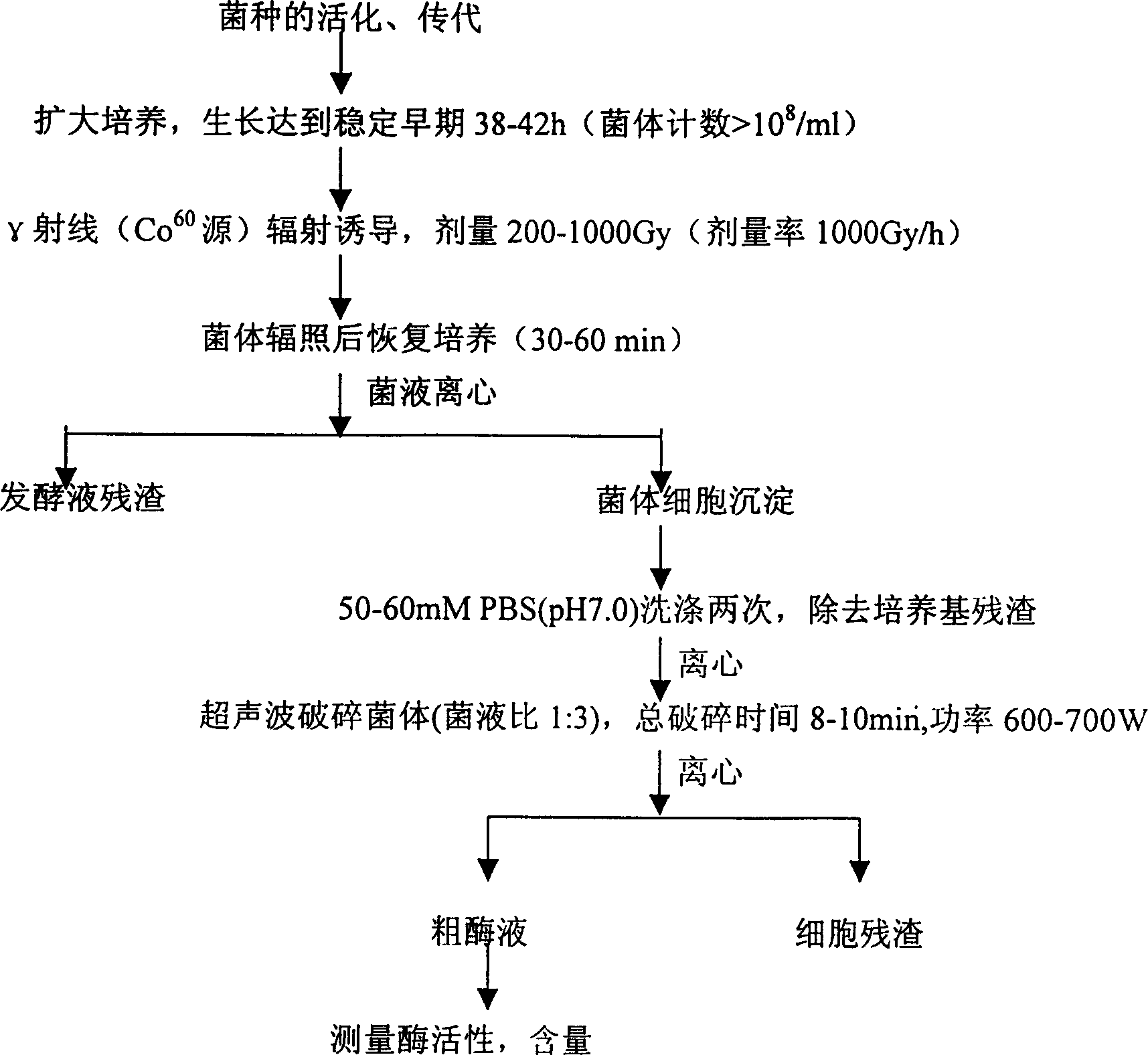Method for increasing yield of superoxide dismutase of radioresistant coccus by radiation induction
A radioresistant coccus, radiation-induced technology, applied in the directions of oxidoreductase, biochemical equipment and methods, enzymes, etc., can solve the problem of SOD carrying pathogens and other problems, and achieve short fermentation culture period, fast strain reproduction, and technological process. simple effect
- Summary
- Abstract
- Description
- Claims
- Application Information
AI Technical Summary
Problems solved by technology
Method used
Image
Examples
Embodiment 1
[0025] Example 1: Taking a dose of 1000Gy radiation to induce 1L bacterial cell culture and recovering culture for 30 minutes as an example.
[0026] 1 Streak-inoculate radiodurans D.radiodurans R1 on TGY solid medium, incubate at 32°C for 45 hours, pick a single colony and inoculate it in 100ml culture medium, and culture it in shake flask for 30 hours. 600 >1.0). The liquid seeds were inserted into 1L of fermentation medium according to the inoculum amount of 5%, and cultured at 32° C. with a stirring rotation speed of 200 rpm. Cultivate for 42 hours until the colony count > 10 8 / ml.
[0027] 2 Divide 1L of bacterial culture into polyethylene tubes (γ-rays can penetrate), and place in Co 60 Under radiation irradiation, the dose rate of 1000Gy / h is irradiated for 1 hour, and the total dose of the bacteria receiving irradiation treatment is 1000Gy.
[0028] 3. The cells induced by radiation were cultured at 32°C for 30 minutes, and the conditions were the same as above. ...
Embodiment 2
[0030] Example 2: Take 200Gy dose of radiation to induce 1L bacterial cell culture, and resume culture for 30 minutes as an example.
[0031] 1 Streak inoculation of radiodurans D.radiodurans R1 on TGY solid medium, culture at 30°C for 48 hours, pick a single colony and inoculate it in a Erlenmeyer flask containing 100ml of culture solution, shake the flask for 30 hours, and the growth of the bacteria reaches the desired level. Phases (OD 600 >1.0). The liquid seeds were inserted into 1L of fermentation medium according to the inoculum amount of 5%, and cultured at 32° C. with a stirring rotation speed of 200 rpm. Cultivate for 40 hours until the colony count > 10 8 / ml.
[0032] 2 Divide 1L of bacterial culture into polyethylene tubes (γ-rays can penetrate), and place in Co 60 Under radiation irradiation, a dose rate of 1000Gy / h was irradiated for 12 minutes, and the total dose of the bacteria received irradiation treatment was 200Gy.
[0033] 3. The cells induced by rad...
Embodiment 3
[0035] Example 3: Take 500Gy dose of radiation to induce 1L bacterial cell culture, and resume culture for 60 minutes as an example.
[0036] 1 Streak-inoculate radiodurans D.radiodurans R1 on TGY solid medium, culture at 32°C for 48 hours, pick a single colony and inoculate it in a triangular flask containing 100ml of culture solution, shake the flask for 30 hours, and the growth of the bacteria reaches the logarithmic phase (OD 600 >1.0). The liquid seeds were inserted into 1L fermentation medium according to the inoculum amount of 3%, cultured at 32°C, and the stirring speed was 220rpm. Cultivate for 38 hours until the colony count > 10 8 / ml.
[0037] 2 Divide 1L of bacterial culture into polyethylene tubes (γ-rays can penetrate), and place in Co 60 Under radiation irradiation, a dose rate of 1000Gy / h was irradiated for 30 minutes, and the total dose of the bacteria received irradiation treatment was 500Gy.
[0038] 3. The cells induced by radiation were cultured at 3...
PUM
| Property | Measurement | Unit |
|---|---|---|
| crush indicators | aaaaa | aaaaa |
Abstract
Description
Claims
Application Information
 Login to View More
Login to View More - R&D
- Intellectual Property
- Life Sciences
- Materials
- Tech Scout
- Unparalleled Data Quality
- Higher Quality Content
- 60% Fewer Hallucinations
Browse by: Latest US Patents, China's latest patents, Technical Efficacy Thesaurus, Application Domain, Technology Topic, Popular Technical Reports.
© 2025 PatSnap. All rights reserved.Legal|Privacy policy|Modern Slavery Act Transparency Statement|Sitemap|About US| Contact US: help@patsnap.com


